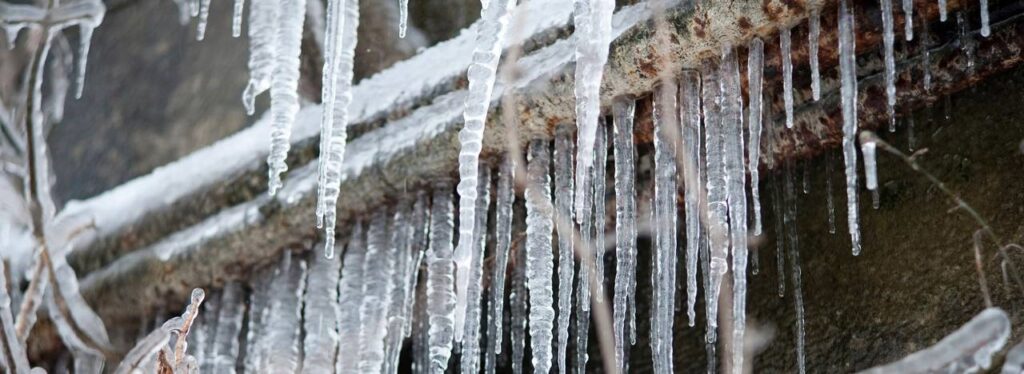The publisher is making a few good points on the subject of Winter Plumbing Precautions: Preventing Frozen Pipes as a whole in this article on the next paragraphs.

Winter can wreak havoc on your pipes, particularly by freezing pipes. Below's how to avoid it from occurring and what to do if it does.
Intro
As temperature levels decline, the risk of frozen pipes boosts, potentially causing pricey repairs and water damage. Comprehending just how to prevent frozen pipes is essential for house owners in chilly climates.
Prevention Tips
Shielding prone pipes
Cover pipelines in insulation sleeves or use heat tape to protect them from freezing temperatures. Focus on pipes in unheated or external locations of the home.
Home heating techniques
Keep indoor rooms adequately warmed, especially locations with plumbing. Open up cabinet doors to permit warm air to distribute around pipelines under sinks.
How to recognize frozen pipes
Try to find decreased water circulation from faucets, unusual odors or sounds from pipes, and noticeable frost on exposed pipes.
Long-Term Solutions
Architectural adjustments
Think about rerouting pipes far from outside wall surfaces or unheated locations. Include extra insulation to attics, basements, and crawl spaces.
Upgrading insulation
Invest in premium insulation for pipelines, attics, and walls. Appropriate insulation assists maintain consistent temperatures and reduces the threat of icy pipelines.
Securing Outside Plumbing
Yard pipes and outside faucets
Separate and drain pipes garden tubes prior to winter season. Install frost-proof faucets or cover outdoor taps with protected caps.
Understanding Icy Pipes
What creates pipes to ice up?
Pipes ice up when exposed to temperature levels below 32 ° F (0 ° C) for prolonged durations. As water inside the pipelines ices up, it broadens, putting pressure on the pipe wall surfaces and potentially creating them to burst.
Dangers and problems
Frozen pipes can cause supply of water disturbances, residential property damages, and expensive repair work. Burst pipelines can flooding homes and create comprehensive architectural damages.
Indications of Frozen Pipes
Determining icy pipelines early can stop them from rupturing.
What to Do If Your Pipes Freeze
Immediate activities to take
If you think frozen pipelines, keep taps available to eliminate pressure as the ice thaws. Make use of a hairdryer or towels soaked in hot water to thaw pipelines slowly.
Verdict
Stopping icy pipelines requires positive actions and quick responses. By recognizing the causes, indications, and safety nets, homeowners can secure their pipes throughout winter.
5 Ways to Prevent Frozen Pipes
Drain Outdoor Faucets and Disconnect Hoses
First, close the shut-off valve that controls the flow of water in the pipe to your outdoor faucet. Then, head outside to disconnect and drain your hose and open the outdoor faucet to allow the water to completely drain out of the line. Turn off the faucet when done. Finally, head back to the shut-off valve and drain the remaining water inside the pipe into a bucket or container. Additionally, if you have a home irrigation system, you should consider hiring an expert to clear the system of water each year.
Insulate Pipes
One of the best and most cost-effective methods for preventing frozen water pipes is to wrap your pipes with insulation. This is especially important for areas in your home that aren’t exposed to heat, such as an attic. We suggest using foam sleeves, which can typically be found at your local hardware store.
Keep Heat Running at 65
Your pipes are located inside your walls, and the temperature there is much colder than the rest of the house. To prevent your pipes from freezing, The Insurance Information Institute suggests that you keep your home heated to at least 65 degrees, even when traveling. You may want to invest in smart devices that can keep an eye on the temperature in your home while you’re away.
Leave Water Dripping
Moving water — even a small trickle — can prevent ice from forming inside your pipes. When freezing temps are imminent, start a drip of water from all faucets that serve exposed pipes. Leaving a few faucets running will also help relieve pressure inside the pipes and help prevent a rupture if the water inside freezes.
Open Cupboard Doors
Warm your kitchen and bathroom pipes by opening cupboards and vanities. You should also leave your interior doors ajar to help warm air circulate evenly throughout your home.

I discovered that post on 6 Ways to Prevent Frozen Pipes while doing a lookup on the web. Do you know somebody who is involved in the niche? Do not hesitate to promote it. Thanks so much for your time spent reading it.
Call Today